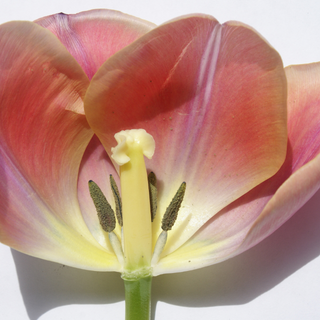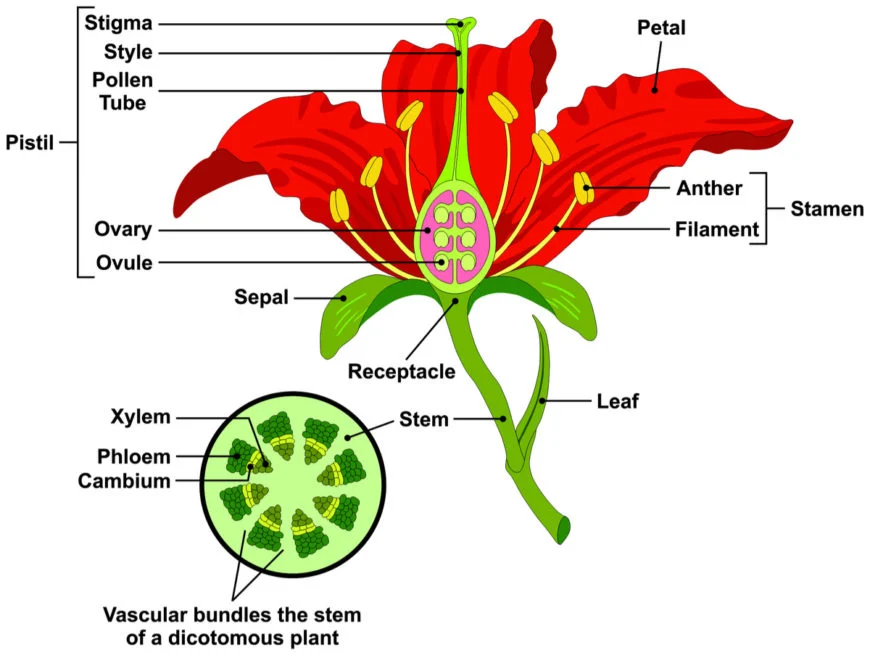
This science video lesson is designed for 6 to 12 years old children to show them different parts of a flower and its function along with the pollination process.
What are Flowers and their Types?
A flower is a typical structure that includes four parts: calyx, corolla, androecium, and gynoecium. Flowers are the reproductive part of a plant. It is also an excellent source of food for many living organisms, such as honeybees, as they are a rich source of nectar.
A flower consists of two different parts:
- Vegetative Part
- Reproductive Part
What are the Functions/ Uses of a flower?
The 7 important functions of a flower are:
- The most prominent function of flowers is reproduction. They help in the union of male and female gametes.
- It helps to develop fruit after fertilization.
- In the absence of fertilization, flowers can produce diaspores.
- Birds and insects benefit from flowers’ nectar, which facilitates the transfer of pollen between flowers.
- It also helps to prepare fragrances.
- Many flowers, such as hibiscus, rose, lavender, etc. are used to make beauty products like creams, soaps, and many more.
- Many flowers like lavender, hibiscus, chamomile, etc., have medicinal properties and are used to prepare herbs and medicines
What are the Different Parts of a Flower?
A typical structure of a flower includes four parts: calyx (sepals), corolla (petals), androecium (stamen), gynoecium (pistil), and pedicels.
Vegetative Parts of a Flower
The vegetative parts of a flower are calyx and corolla.
Calyx
The calyx is the outermost part of a flower. It comprises sepals and receptacles (tiny leaves present at the base of a flower and is a part of a flower stalk). It gives the flower strength and protects it from mechanical injuries and dryness.
Fun facts about calyx
- Some plants have colored sepals and are called petaloid.
- Flowers where sepals fall off before they open fully are known as caducous. Flowers where sepals fall after fertilization are known as deciduous.
Corolla
Corolla is the second part of the plant. It comprises petals. It has two functions:
- To attract pollinators such as bees, animals, etc.
- To protect the reproductive organs of a flower.
Thus, petals are brightly colored and scented to fulfill the above two functions.
The calyx and corolla are collectively known as the perianth.
Reproductive Parts of a Flower
The reproductive parts of a flower comprise stamen and carpels.
Stamens (the male reproductive part of the flower)
Stamen is the third part of the flower. It is also known as Androecium. It comprises a filament and anthers.
- Anthers: An anther is a circular, yellowish, sac-like structure in the middle of petals. It helps in producing and storing the pollen.
- Filament: The filament is a slender, thread-like structure with anthers on the top. It helps in supporting anthers.
Fun fact:
- All the stamens do not bear fertile anthers.
Carpels
The carpel is the fourth part of the flower. It is present in the center of the flower.
It contains the pistil that further comprises the ovary, style, and stigma.
Pistil
The pistil is the innermost part of the flower. It is also known as the female reproductive organ of a flower. It comprises three parts: stigma, style, and ovary, which is collectively known as the pistil. Let us learn about them one by one.
- Stigma: The stigma on a flower is the topmost, vertical part of the gynoecium, which serves as a receptive tip.
- Ovary: Ovary is the ductless reproductive gland to hold numerous ovules or eggs. It helps in seed formation.
- Style: Style is a long, narrow stalk that connects the stigma and the ovary.
Fun facts
- Sometimes, the ovary turns into the fruit to hold the seeds after fertilization.
- When pollens are dispersed, they stick to the stigma and travel down the style to the ovary.
Pedicels
It is a long, green-colored stalk of the flower.
We have now learned about various types of flower and their parts and function. Now, let us understand the pollination and fertilization process.
What is Pollination?
Pollination is the process of transferring pollen from one stigma to another. Pollination occurs through a different medium and can be of two types:
- a) Self Pollination occurs when pollen grains are transferred from the anther to the stigma of the same flower or another flower on the same plant.
- b) Cross-Pollination occurs when pollen grains are transferred from the anther of a flower of one plant to the stigma of a flower of another plant.
Factors that help in cross-pollination:
- Air/wind
- Insects such as butterflies, moths, and bees
- Animals/Humans
What is Fertilization?
Fertilization is the fusion of male and female gametes in the flowers of the plant and forms a fruit.
Process of Fertilization
Once self-pollen grains reach the stigma, they germinate and develop a pollen tube that passes through the style of the carpel and then the ovary. Through the ovary, it enters an ovule through its micropyle. Ovule then carries two male gametes and a tube nucleus and reaches the embryo sac. After reaching there, it bursts open to release male gametes, which fuse with the egg or ovum to form a diploid zygote. Zygote further undergoes a series of divisions and stages to form an embryo that later develops into new plants.
For easy understanding, the video lesson uses a model cut-out with labeled parts of a flower. The parts of a flower are repeated throughout the video while pointing to the relevant part.
Video helps the child in exploring and identifying different parts of a flower by looking at them. A child will learn how flowers work with insects to create a process called Pollination. This process also helps the child to understand the importance of flowers in nature.
Click here to watch the video…
To watch more science lessons, click here.
Video created by: Strykun Olena
Frequently Asked Questions
- What are the important parts of a flower?
The 5 important parts of a flower include:
-
- Sepals
- Petals
- Stamens
- Pistil
- Pedicels
- How do flowers reproduce?
Flowers reproduce by a process called pollination. In this process, the male gametes are transferred to the female ovules where fertilization occurs and ovules grow into seeds within a fruit.
- What are the reproductive parts of a flower?
Reproductive parts of the plant are the stamen and the pistil. Stamen is the male reproductive part of a flower, while the pistil is the female reproductive part of a flower.
- What is the primary function of a flower?
The most prominent function of flowers is reproduction in the plant by producing male and female gametes.
- Which is the female part of the flower?
The female part of the flower is known as the pistil or carpel.
Tags
- elementary level
- English
- Montessori at home
- science






